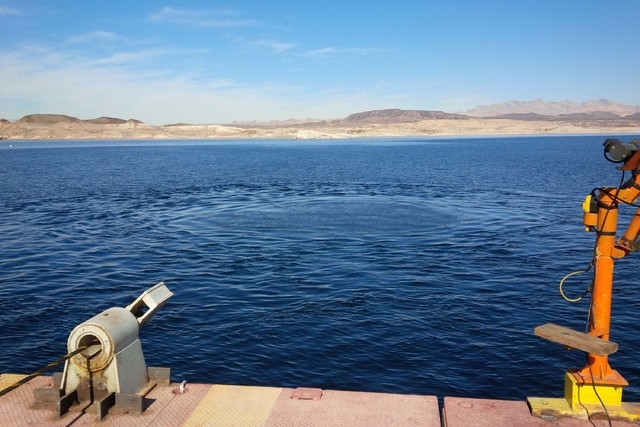Work on $650 million Lake Mead pump station starts

On an island at Lake Mead that stopped being an island more than a decade ago, the Southern Nevada Water Authority is about to launch the next phase of a 12-year building binge expected to last until 2020 and cost almost $1.5 billion.
Design work is underway for a new $650 million deep-water pumping station that will draw from the very bottom of the lake. Seven construction firms have bid to build the facility on Lake Mead’s Saddle Island, which scarcely qualifies as a peninsula these days with the reservoir approaching another historic low.
The water authority board will be asked to pick a contractor at its May meeting, said Erika Moonin, an engineer and project manager for the valley’s wholesale water supplier. Initial construction could begin in June, even while the structure is still being designed.
This latest job is gearing up just as the previous one nears completion on Saddle Island, where an Italy-based construction team has spent the past seven years building a 20-foot water intake tunnel to the deepest part of the lake, three miles from shore. That $817 million project is to go online by the end of summer after a series of setbacks that added almost $40 million to the cost and delayed completion by more than two years.
The intake tunnel was designed and built by Vegas Tunnel Constructors, a subsidiary of Italian construction giant Impregilo.
The authority is taking a different approach this time around. Instead of entering into another design-build contract, the agency will, for the first time, hand the project over to what is known as a “construction manager at-risk.”
That means a contractor is selected based on qualifications while the blueprints are still being drawn up and then commits to working closely with the project’s owner and design firm to deliver the finished product at or below a predetermined maximum price.
Water authority spokesman Bronson Mack said using a construction manager at-risk should expedite the work, help contain costs and give the authority more direct input on the finished design for what he described as a “very technical facility … that we will operate daily.”
The pumping station is expected to take about five years to build and is being paid for with an infrastructure surcharge that will start showing up on customers’ water bills in January.
The finished station will expand the reach of the new intake tunnel, allowing it to keep drawing enough water for the entire community even if the lake plummets another 210 feet to so-called “dead pool,” a once-unthinkable low point at which Hoover Dam can no longer release water downstream.
Moonin called it “a really critical project” for the valley, especially in light of worsening projections for the reservoir that supplies 90 percent of the local water supply.
“Even if there’s no water moving through Hoover Dam, we’ll still be able to draw water for the community,” she said.
Plans for the new intake originally included a pump station, but authority officials decided to defer that part of the project in the midst of recession in 2008 to save the agency roughly $300 million.
The project has more than doubled in cost in the six years since, but Moonin said deferring the work was a “very sound decision” in hindsight because the facility now being built reaches 125 feet deeper in the lake and will pump 50 percent more water than the previous version.
As recently as 2006, she said, it never occurred to them to sink a pump station so deep into the lake because no one thought they would ever need one.
“It wasn’t a real threat that (Lake Mead) would go that low,” Moonin said.
Work on the facility will begin with the excavation of a vertical access shaft reaching 520 feet underground so workers can drill and blast a large subterranean chamber that will serve as the forebay for the pumping station. The contractor also will have to drill more than 30 vertical well shafts, each about 500 feet deep and built to house specialized pumping equipment made only by two manufacturers in the world, Moonin said.
The finished project will be able to pump 900 million gallons per day, 353 million gallons more than the authority’s peak water delivery for a single day last year.
Moving that much water will require a great deal of energy — something on the order of 82 megawatts of electricity for average daily operations, or roughly the same used by 14,000 mid-sized valley homes, Mack said.
A single gallon of water weighs 8½ pounds. On a peak day in the summer, the authority must deliver more than 500 million gallons roughly 2,500 feet uphill from Lake Mead to the farthest reaches of Summerlin. The new pumping station in the shrinking reservoir will add another 150 vertical feet to that journey.
There is some good news, Mack said: The pumping station and new intake should be the last big-ticket items for a while, at least at Lake Mead.
“For the foreseeable future, in terms of major infrastructure at Lake Mead, we think this will be it,” Mack said.
Contact Henry Brean at hbrean@reviewjournal.com or 702-383-0350. Find him on Twitter: @RefriedBrean


















